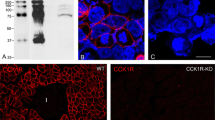Summary
The size, number and volume per cell of secretion granules in rat exocrine pancreas have been measured using stereological techniques. The changes which occur as a result of feeding starved animals (90 min) or stimulating lobular fragments in vitro with carbachol are documented. In fasted animals mean acinar cell volume was estimated as 1670 μm3 and the cells contained an average of around 450 secretion granules with a corrected mean diameter of 0.70 μm. They occupied around 7% of cell volume. After feeding mean cell volume was about 1300 μm3 and the cells contained an average of about 190 granules per cell with a mean diameter of 0.58 μm. They occupied 3% of cell volume. A shift in the size frequency distribution of granule diameters occurred as a result of feeding. In vitro experiments in which lobules were induced to secrete with carbachol (10μM, 3 h, 37° C) had a similar effect. Mean cell volume was reduced from around 1760 μm3 to 1360 μm3, mean granule number from around 420 per cell to 180 per cell and the volume density of granules was reduced from about 8% to 3% of cell volume. There was no significant change in mean granule diameter or shift in the size-frequency distribution of granule diameters. Incubation of tissues with cycloheximide (1 mM, 3 h, 37° C) did not prevent secretion by carbachol but it prevented replacement of granules. As a consequence, depletion by carbachol was greater in the presence of cycloheximide, the granules being reduced to around 110 per cell and to only 2.5% of cell volume. We conclude that feeding causes a preferential loss of larger granules and that during secretion replacement of granules occurs. Some of these granules are smaller than those evident in the glands of starved animals.
Similar content being viewed by others
References
Bailey NTJ (1981) Statistical methods in biology, 2nd edn, Hodder and Stoughton, London, Sydney, Auckland, Toronto
Beaudoin AR, Grondin G, Filion M, Lord A (1984) Secretogogues cause a preferential discharge of large size granules in rat pancreas. Can J Biochem Cell Biol 62:1288–1292
Bedi KS, Cope GH, Williams MA (1974) An electron microscopic analysis of the zymogen granule content of the parotid gland of starved rabbits and of the changes induced by feeding. Arch Oral Biol 19:1127–1136
Bolender RP (1974) Stereological analysis of the guinea-pig pancreas. I. Analytical model and quantitative description of nonstimulated pancreatic exocrine cells. J Cell Biol 61:269–287
Case RM (1978) Synthesis, intracellular transport and discharge in the pancreatic acinar cell and other cells. Biol Rev 53:211–354
Cope GH (1982) Stereological techniques and their application to the gastrointestinal tract and its glands. In: Titchen DA (ed) Techniques in the Life Sciences, vol. P2, Digestive Physiology P 201, Elsevier Scientific Publishers, Ireland Ltd. pp 1–33
Cope GH, Williams MA (1981) Secretion granule formation in the rabbit parotid gland after isoprenaline-induced secretion. Stereological reconstructions of granule populations. Anat Rec 199:377–392
Ermak TH, Rothman SS (1981) Zymogen granules of the pancreas decrease in size in response to feeding. Cell Tissue Res 214:51–66
Ermak TH, Rothman SS (1983) Increase in zymogen granule volume accounts for increase in volume density during prenatal development of pancreas. Anat Rec 207:487–501
Gundersen HJG (1977) Notes on the estimation of numerical density of arbitrary profiles: The edge effect. J Microsc 111:219–211
Jamieson JD, Palade GE (1968) Intracellular transport of secretory proteins in the pancreatic acinar cell. III Dissociation of intracellular transport from protein synthesis. J Cell Biol 39:580–588
Kramer MF, Poort C (1972) Unstimulated secretion of protein from rat exocrine pancreas cells. J Cell Biol 52:147–158
Liebow C, Rothman SS (1973) Distribution of zymogen granule size. Am J Physiol 225:258–262
Loud AV (1968) A quantitative stereological description of the ultrastructure of normal rat liver parenchymal cells. J Cell Biol 37:27–36
Nadelhaft I (1973) Measurement of the size distribution of zymogen granules from rat pancreas. Biophys J 13:1014–1029
Nevalainen TJ (1970) Effects of pilocarpine stimulation on rat pancreatic acinar cells. An electron microscopic study with morphometric analysis. Acta Pathol Microbiol Scand [Suppl] 210:9–47
Phaneuf S, Grondin G, Roberge M, Lord A, Beaudoin AR (1985) Cytological effects of ionophore-induced stimulation on the exocrine pancreas of the rat. Cell Tissue Res 239:105–109
Putzke HP, Said F (1975) Different secretory responses of periinsular and other acini in the rat pancreas after pilocarpine injection. Cell Tissue Res 161:133–143
Roberge M, Grondin G, Larose L, Beaudoin AR (1981) Cytological effects of urecholine stimulation on the rat pancreas. Cell Tissue Res 220:781–786
Rose PE (1980) Improved tables for the evaluation of sphere size distribution including the effects of section thickness. J Microsc 118:135–141
Rothman SS (1975) Protein transport by the pancreas. Science 190:747–753
Scheele GA, Palade GE (1975) Studies on the guinea-pig pancreas. Parallel discharge of exocrine enzyme activities. J Biol Chem 250:2660–2670
Selinger Z, Sharoni Y, Schramm M (1974) Modification of the secretory granule during secretion in the rat parotid gland. In: Ceccarelli B, Clementi F, Melddesi J (eds) Advances in Cytopharmacology, vol 2. Raven Press Publishers, New York, pp 23–28
Sharoni Y, Eimerl S, Schramm M (1976) Secretion of old versus new exportable protein in rat parotid slices. Control by neurotransmitters. J Cell Biol 71:107–122
Uchiyama Y, Saito K (1982) A morphometric study of 24-hour variations in subcellular structures of the rat pancreatic acinar cell. Cell Tissue Res 226:609–620
Weibel ER (1979) Stereological Methods, vol 1. Practical Methods for Biological Morphometry, Academic Press, London, New York, Sydney
Weibel ER, Gomez DM (1962) A principle for counting tissue structures on random sections. J Appl Physiol 17:343–349
Weibel ER, Paumgartner D (1978) Integrated stereological and biochemical studies on hepatocyte membranes: II. Correction of section thickness effects on volume and surface density estimates. J Cell Biol 77:584–593
Author information
Authors and Affiliations
Rights and permissions
About this article
Cite this article
Aughsteen, A.A., Cope, G.H. Changes in the size and number of secretion granules in the rat exocrine pancreas induced by feeding or stimulation in vitro. Cell Tissue Res. 249, 427–436 (1987). https://doi.org/10.1007/BF00215527
Accepted:
Issue Date:
DOI: https://doi.org/10.1007/BF00215527




